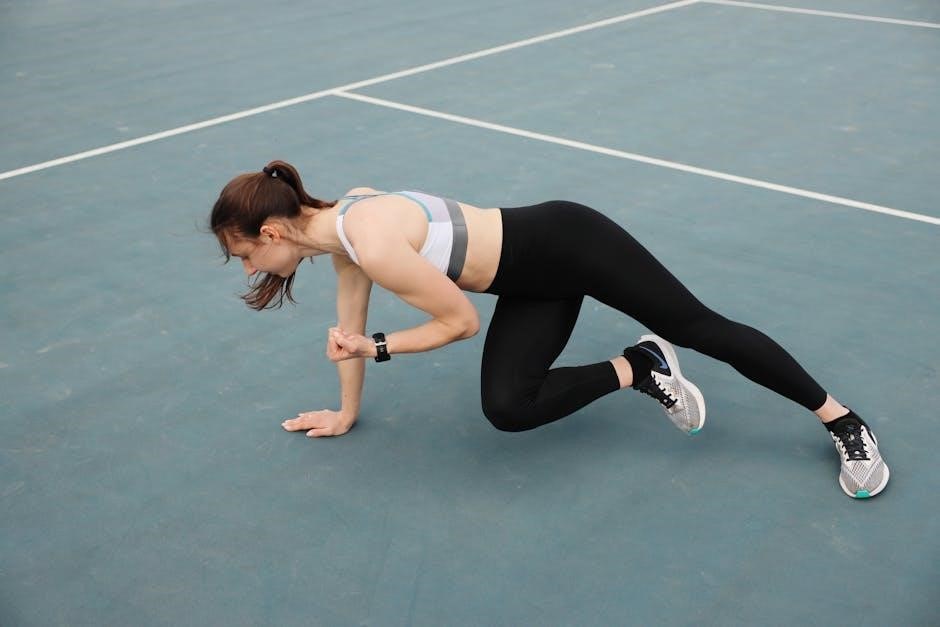Piriformis exercises are essential for targeting the piriformis muscle, which plays a crucial role in hip stability and movement. These exercises help prevent disorders like piriformis syndrome and alleviate sciatica pain. A PDF guide provides a comprehensive and portable resource, offering structured routines to improve flexibility, strength, and overall lower body function.
1.1 What Is the Piriformis Muscle?
The piriformis muscle is a small, deep muscle located in the buttocks, beneath the gluteal muscles. It plays a key role in hip rotation and stabilization, helping to rotate the leg outward. The piriformis muscle is closely associated with the sciatic nerve, which can sometimes become compressed or irritated, leading to discomfort. Tightness or inflammation in this muscle can cause pain in the buttocks and potentially radiate down the leg, contributing to conditions like piriformis syndrome. Understanding its function and location is crucial for effectively targeting it with exercises to improve mobility and reduce discomfort.
1.2 Importance of Piriformis Exercises
Piriformis exercises are crucial for maintaining hip health and preventing discomfort. They help relieve tightness, improve flexibility, and strengthen the muscle, reducing the risk of piriformis syndrome. Regular exercises can alleviate sciatica pain by reducing pressure on the sciatic nerve. Strengthening the piriformis also enhances lower back stability and overall mobility. Incorporating these exercises into a routine promotes long-term muscle health and prevents future issues. A structured approach, such as that found in a PDF guide, ensures consistency and effectiveness in addressing both prevention and recovery.
1.3 Benefits of Using a PDF Guide for Piriformis Exercises
A PDF guide for piriformis exercises offers numerous benefits, including portability and easy access to structured routines. It provides clear instructions, images, and diagrams to ensure proper form and technique. The guide allows users to track progress and stay motivated with organized workout plans. Additionally, it serves as a convenient reference for home or gym use, eliminating the need for internet access. Many PDF guides include video tutorials and adjustable routines, catering to different fitness levels. This resource is ideal for those seeking a comprehensive, cost-effective solution to manage piriformis-related discomfort and improve overall hip health.

Understanding Piriformis Syndrome
Piriformis syndrome involves inflammation or tightness of the piriformis muscle, often compressing the sciatic nerve and causing pain. It can result from overuse, poor posture, or prolonged sitting. Stretching and strengthening exercises, detailed in a PDF guide, help alleviate symptoms and restore muscle balance, promoting recovery and preventing future discomfort.
2.1 What Is Piriformis Syndrome?
Piriformis syndrome is a condition characterized by inflammation or tightness of the piriformis muscle, which can compress the sciatic nerve; This compression leads to pain in the buttocks and thighs, often mimicking sciatica. The piriformis muscle, located deep in the buttocks, plays a key role in hip rotation and stability. When it becomes inflamed or spasms, it can irritate the nearby sciatic nerve, causing discomfort. Exercises, including stretching and strengthening routines, are essential for managing the condition and relieving symptoms. A PDF guide provides structured workouts to address piriformis syndrome effectively.
2.2 Common Symptoms of Piriformis Syndrome
Piriformis syndrome often presents with pain in the buttocks and thighs, mimicking sciatica. Symptoms may include tenderness in the buttock region, difficulty sitting comfortably, and pain that worsens with prolonged sitting or activities like bending forward. Some individuals experience radiating pain along the back of the leg, though it typically does not extend below the knee. Tightness or stiffness in the hip area is also common. These symptoms can significantly impact daily activities and mobility. Addressing these issues through targeted exercises, as outlined in a piriformis exercises PDF, can help alleviate discomfort and restore normal function.
2.3 Causes of Piriformis Syndrome
Piriformis syndrome is often caused by inflammation or tightness of the piriformis muscle, which can compress the nearby sciatic nerve. Common triggers include prolonged sitting, repetitive movements, or overuse from physical activities. Muscle imbalances, where the piriformis becomes overactive while other hip muscles are weak, can also contribute. Direct trauma to the buttock area or sudden contractions of the muscle may initiate symptoms. Additionally, conditions like arthritis or poor posture can exacerbate tension in the piriformis. These factors lead to irritation of the sciatic nerve, resulting in pain and discomfort. A piriformis exercises PDF can provide targeted routines to address these underlying causes.
2.4 Role of Exercises in Managing Piriformis Syndrome
Exercises play a crucial role in managing piriformis syndrome by reducing muscle tightness and alleviating sciatic nerve compression. Stretching exercises help relieve tension in the piriformis, while strengthening exercises improve hip stability and overall muscle balance. A combination of these approaches can provide significant relief from symptoms. Regular exercise routines, outlined in a piriformis exercises PDF, offer a structured plan to address both acute and chronic issues. Consistency in performing these exercises is key to preventing recurrence and maintaining long-term comfort and mobility.

Benefits of Piriformis Exercises
Piriformis exercises offer numerous benefits, including sciatica pain relief, enhanced hip flexibility, and stronger glutes. They also prevent muscle tightness and improve mobility effectively.
3.1 Relief from Sciatica Pain
Piriformis exercises are highly effective in alleviating sciatica pain, which often arises from a tight or inflamed piriformis muscle compressing the sciatic nerve. Gentle stretching exercises, such as the seated and supine piriformis stretches, can help reduce nerve compression and alleviate discomfort. Strengthening exercises, like clamshell and bird dog, improve muscle balance and support the lower back, further reducing pain. Regular practice of these exercises, as outlined in a PDF guide, can provide long-term relief and prevent sciatica flare-ups, enhancing overall quality of life.
3.2 Improving Hip Flexibility
Piriformis exercises are crucial for enhancing hip flexibility by targeting the piriformis muscle, which often becomes tight and restricts movement. Stretching exercises like the seated piriformis stretch and supine piriformis stretch help lengthen the muscle, improving range of motion. Regular practice reduces hip stiffness and enhances mobility, making daily activities easier. Strengthening exercises, such as clamshell and side-lying abduction, also promote balanced hip function. A well-structured PDF guide provides clear routines to gradually increase flexibility and maintain healthy hip joints, ensuring long-term mobility and comfort.
3.3 Strengthening the Glutes and Lower Back
Strengthening the glutes and lower back is vital for overall hip and pelvic stability. Piriformis exercises like the clamshell and side-lying abduction target these areas, enhancing muscle endurance and power. A stronger lower back and glutes provide better support for the hips, reducing the risk of injury and alleviating sciatica pain. Regular practice improves posture, balances muscle development, and enhances athletic performance; Incorporating these exercises into a routine, as outlined in a PDF guide, ensures a well-rounded approach to muscle health and long-term stability in the lower body.
3.4 Preventing Tightness and Improving Mobility
Piriformis exercises are key to preventing tightness and enhancing mobility in the hips and lower body. Regular stretching and strengthening routines help maintain flexibility, reducing the risk of muscle stiffness. Exercises like the pigeon pose and seated piriformis stretch target the muscle directly, promoting relaxation and improved range of motion. Consistent practice prevents tightness, which can lead to discomfort or injury. By incorporating these exercises into a daily or weekly routine, individuals can enjoy better mobility and reduced muscle tension. A PDF guide provides clear instructions, ensuring proper form and effectiveness in achieving these benefits.

Stretching Exercises for the Piriformis
Stretching the piriformis muscle can be done through seated, supine, and standing exercises, along with the use of foam rollers for deeper relief. Consistency is key to maintaining flexibility and preventing tightness, ensuring optimal hip mobility and reducing discomfort. A PDF guide provides detailed instructions for safely performing these stretches at home, helping to alleviate tension and improve overall muscle function.
4.1 Seated Piriformis Stretch
The seated piriformis stretch is an effective way to target the muscle while minimizing strain. Sit on a chair and place your right ankle above your left knee, allowing your leg to roll outward. Gently press down on your right knee with your hand until you feel a stretch in your buttocks. Hold for 30 seconds and repeat on the other side. This stretch is ideal for improving hip flexibility and can be done anywhere with a chair. Regular practice helps relieve tightness and reduces the risk of piriformis syndrome.

4.2 Supine Piriformis Stretch
Lie on your back with knees bent and feet flat on the floor. Cross the affected leg over the other thigh, forming a figure-4 shape. Gently pull the unaffected leg toward your chest until a stretch is felt in the buttocks. Hold for 30 seconds, breathing deeply. Repeat 2-3 times on each side. This stretch targets the piriformis muscle effectively without putting pressure on the hips. It’s ideal for those who prefer lying down and is particularly beneficial for relieving sciatica pain and promoting muscle relaxation. For a deeper stretch, use a towel or strap to assist the pull.
4.3 Standing Piriformis Stretch
Stand with your feet shoulder-width apart. Cross the affected leg over the other thigh, placing the ankle just above the knee. Bend your knee slightly and lean toward the unaffected side until a stretch is felt in the buttocks. Hold for 20-30 seconds, then switch sides. This stretch is excellent for targeting the piriformis muscle while maintaining an upright posture. It’s ideal for individuals who find seated or lying stretches uncomfortable. Regular practice can improve hip flexibility and reduce tension in the lower back. For enhanced effectiveness, incorporate deep breathing to relax the muscle further during the stretch.
4.4 Pigeon Pose for Piriformis Stretch
Start on your hands and knees. Bring one knee forward, placing your foot on the ground in front of the other knee. Extend the other leg behind you, keeping the foot flexed. Lower your hips down toward the ground, ensuring the stretch is felt in the buttocks of the front leg. Hold for 20-30 seconds and switch sides. This yoga-based stretch deeply targets the piriformis muscle, providing relief from sciatica pain and improving hip mobility. Modify the stretch by using a cushion for comfort or adjusting the depth to suit your flexibility level. Deep breathing enhances relaxation during the stretch.
4.5 Piriformis Stretch with a Foam Roller
Using a foam roller is an effective way to release tension in the piriformis muscle. Lie on the floor with your knees bent and feet flat. Place the foam roller under your buttocks, targeting the piriformis area. Slowly roll back and forth, applying gentle to moderate pressure. Focus on areas that feel tight or tender. This self-myofascial release technique helps relieve sciatica pain, improves circulation, and reduces muscle stiffness. Adjust the pressure as needed for comfort and repeat for 2-3 minutes. Incorporate deep breathing to enhance relaxation and maximize the stretch’s benefits. Regular use can prevent piriformis tightness and improve hip mobility.
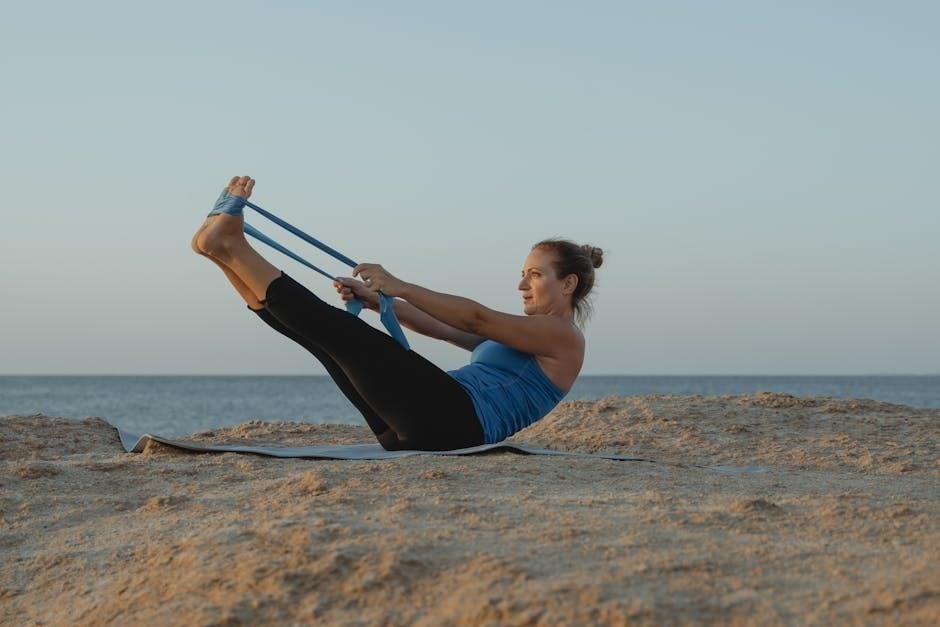
Strengthening Exercises for the Piriformis
Strengthening the piriformis enhances hip stability and posture. Exercises like clamshell and side-lying abduction target the muscle, improving lower back support and glute function for better overall muscle balance.
5.1 Clamshell Exercise
The clamshell exercise is an effective way to strengthen the piriformis muscle. Lie on your side with knees bent and feet touching. Slowly lift the top knee while keeping feet together, squeezing the glutes at the top. This movement targets the piriformis and gluteus medius, improving hip stability and reducing muscle imbalances. Perform 2-3 sets of 15-20 repetitions for optimal results. This exercise is ideal for those seeking to enhance lower back support and improve posture, making it a cornerstone in piriformis exercise routines.
5.2 Side-Lying Abduction
The side-lying abduction is a powerful exercise for strengthening the piriformis and gluteus medius muscles. Lie on your side with legs straight and feet touching. Slowly lift the top leg away from the bottom leg while keeping hips stable. Focus on initiating the movement from the hip, not the knee. Lower the leg slowly to the starting position; Perform 2-3 sets of 15-20 repetitions. This exercise enhances hip abduction strength, improves balance, and supports proper gait mechanics. Proper form is essential to avoid straining the lower back and maximize piriformis engagement.
5.3 Bird Dog Exercise
The bird dog exercise is an effective movement for strengthening the piriformis muscle while improving core stability and balance. Start on your hands and knees. Extend one arm and the opposite leg simultaneously, keeping them straight. Hold the position briefly, then return to the starting point. Perform 2-3 sets of 10-12 repetitions per side. This exercise enhances coordination and engages both the piriformis and lower back muscles. Proper form is key to avoid strain and ensure optimal muscle activation. It’s a versatile exercise that can be modified to suit different fitness levels and incorporated into various workout routines for comprehensive strength training.
5.4 Hip Abduction with Resistance Band
Hip abduction with a resistance band is an excellent exercise for strengthening the piriformis muscle and improving hip mobility. Anchor the band at hip height and loop the other end around your ankle. Stand sideways to the anchor point, maintaining a slight tension in the band. Slowly lift your leg away from your body, keeping it straight, until you feel resistance. Hold briefly, then lower your leg back to the starting position. Perform 2-3 sets of 12-15 repetitions per side. This exercise targets the piriformis effectively while enhancing overall hip stability and strength. It’s a great addition to a structured workout routine.
5.5 Glute Bridges for Piriformis Strengthening
Glute bridges are a powerful exercise for strengthening the piriformis muscle and enhancing lower back stability. Lie on your back with knees bent and feet flat on the floor. Slowly lift your hips towards the ceiling, squeezing your glutes at the top of the movement. Focus on engaging your piriformis muscle as you lift. Lower your hips back down slowly to the starting position. Perform 2-3 sets of 12-15 repetitions. This exercise not only strengthens the piriformis but also improves hip extension and overall posterior chain strength, making it a versatile addition to any workout routine. It’s effective and easy to incorporate into daily training.

Piriformis Exercises for Sciatica Relief
Piriformis exercises for sciatica relief focus on gentle stretching and strengthening to alleviate pain and improve mobility. These exercises are effective and easy to follow, especially with a PDF guide.
6.1 Gentle Stretching to Alleviate Sciatica Pain
Gentle stretching is a cornerstone of managing sciatica pain related to piriformis tightness. Techniques like the seated piriformis stretch and the pigeon pose target the muscle, reducing nerve compression. These exercises, often detailed in PDF guides, emphasize controlled movements to avoid aggravating the condition. By improving flexibility and reducing muscle spasms, gentle stretching provides immediate relief and supports long-term recovery. Regular practice helps maintain hip alignment and prevents sciatic nerve irritation, making it a vital component of any treatment plan for piriformis-related sciatica.
6.2 Strengthening Exercises to Support the Lower Back
Strengthening exercises are crucial for supporting the lower back and alleviating sciatica pain. Exercises like bird dog, clamshell, and glute bridges target the piriformis and surrounding muscles, enhancing stability and reducing strain on the sciatic nerve. These routines, often outlined in PDF guides, focus on gradual progression to build strength without overloading the muscles. By improving core and gluteal strength, these exercises help maintain proper posture and reduce the risk of lower back strain, providing a robust foundation for managing piriformis-related sciatica effectively. Regular practice ensures long-term relief and prevents future episodes of pain and discomfort.
6.3 Combining Stretching and Strengthening for Optimal Relief
Combining stretching and strengthening exercises is key to achieving optimal relief from piriformis-related sciatica. Stretching improves flexibility, reduces muscle tightness, and alleviates pressure on the sciatic nerve, while strengthening builds muscle support and stability. This dual approach helps restore balance to the hip and lower back, preventing future flare-ups. A well-structured PDF guide often includes routines that blend these techniques, offering a holistic plan for managing symptoms. Consistency in practice ensures sustained relief and enhances overall muscle function, making it easier to maintain daily activities without discomfort or pain.
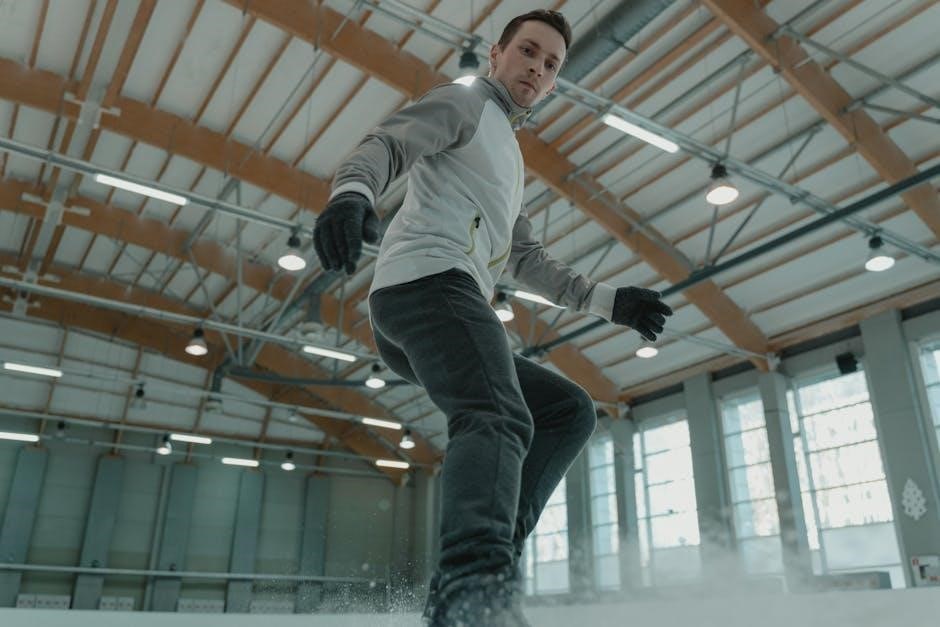
Creating a Piriformis Exercise Routine
Creating a piriformis exercise routine involves a balanced approach, combining warm-ups, core strengthening, and targeted stretches. A PDF guide can help structure these elements effectively for relief and prevention.
7.1 Warm-Up Exercises
Warm-up exercises are essential to prepare the piriformis muscle and surrounding tissues for more intense workouts. Gentle movements like seated piriformis stretches or supine stretches can increase blood flow and flexibility. Bird dog exercises and light hip rotations are also effective for activating the lower back and glutes. These exercises help prevent injury and improve mobility. A well-structured PDF guide can provide clear instructions for proper warm-up techniques, ensuring a safe and effective routine. Consistency in warm-ups enhances the overall benefits of piriformis exercises and supports long-term muscle health.
7.2 Core Strengthening Exercises
Core strengthening exercises are vital for improving stability and balance, which directly support piriformis function. Exercises like bird dog, clamshell, and glute bridges target the core muscles, enhancing hip and lower back stability. Strengthening the transverse abdominis and obliques helps maintain proper posture and reduces strain on the piriformis. A PDF guide often includes detailed routines that combine core work with piriformis-specific movements, ensuring a holistic approach to muscle development. Regular core exercises not only improve athletic performance but also aid in preventing injuries and alleviating discomfort associated with piriformis tightness or syndrome.
7.3 Cool-Down and Stretching
A proper cool-down with stretching is essential after piriformis exercises to promote muscle relaxation and prevent tightness. Gentle stretches like the seated piriformis stretch and supine piriformis stretch help lengthen the muscle, reducing post-exercise soreness. Incorporating deep breathing during these stretches enhances relaxation and improves flexibility. A PDF guide often includes visual aids and step-by-step instructions for effective cool-down routines. Regular stretching after workouts ensures long-term muscle health and supports overall recovery, making it a crucial component of any piriformis exercise program.
7.4 Sample Routine for Piriformis Syndrome
A sample routine for piriformis syndrome includes a mix of stretching and strengthening exercises. Begin with a 5-10 minute warm-up, such as light walking or cycling, to prepare the muscles. Perform stretches like the seated piriformis stretch, supine piriformis stretch, and pigeon pose to relieve tightness. Strengthening exercises, such as clamshells, side-lying abductions, and glute bridges, should follow to improve muscle stability. End with a cool-down, incorporating gentle stretches to enhance flexibility and reduce muscle soreness. This routine can be repeated 2-3 times a week for optimal results. A PDF guide often provides detailed visuals and step-by-step instructions for each exercise.
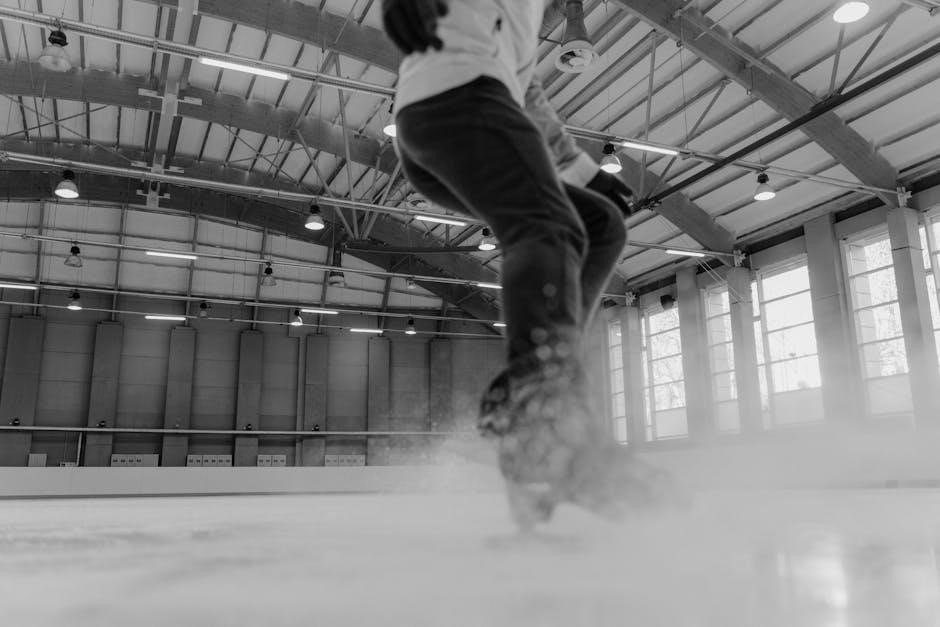
Using a PDF Guide for Piriformis Exercises
A PDF guide for piriformis exercises offers a structured, printable resource with detailed instructions, visuals, and routines to enhance flexibility, strength, and proper form for optimal results.
8.1 Advantages of a Printable PDF Guide
A printable PDF guide for piriformis exercises offers unmatched accessibility and convenience. It allows users to access detailed workout routines anytime, without internet dependency, making it ideal for home or gym use. The guide often includes clear visuals and step-by-step instructions, ensuring proper form and technique. Portability is another key benefit, as it can be easily carried or shared with trainers. Additionally, printable guides enable users to track progress and mark completed exercises, providing a sense of accomplishment. This structured approach helps maintain consistency, leading to better results in managing piriformis-related discomfort and improving overall hip and lower back health effectively.
8.2 How to Use the PDF Guide Effectively
Start by reviewing the entire PDF guide to understand the structure and exercise progression. Begin with the warm-up section to prepare your muscles. Focus on the stretching exercises first, following the step-by-step instructions and visuals to ensure proper form. Gradually incorporate strengthening exercises, adjusting resistance or repetitions as needed. Track your progress by marking completed exercises and noting improvements. Cool down after each session and revisit the guide regularly to refine your technique. Consistency is key, so schedule regular practice and stay committed to achieve optimal results for your piriformis health and overall mobility.
8.3 Importance of Progression in Exercises
Progression in piriformis exercises is crucial for avoiding plateaus and ensuring continuous improvement. Start with gentle stretches to build flexibility and gradually introduce strengthening exercises to enhance muscle stability. As you advance, increase resistance using bands or weights. Incorporate dynamic movements to improve functional mobility. Avoid overexertion by listening to your body and adjusting intensity. Consistent progression ensures the piriformis muscle remains balanced, reducing the risk of injury and promoting long-term recovery from conditions like piriformis syndrome. Regularly reassess your routine to keep challenging yourself and achieving optimal results for hip and lower back health.
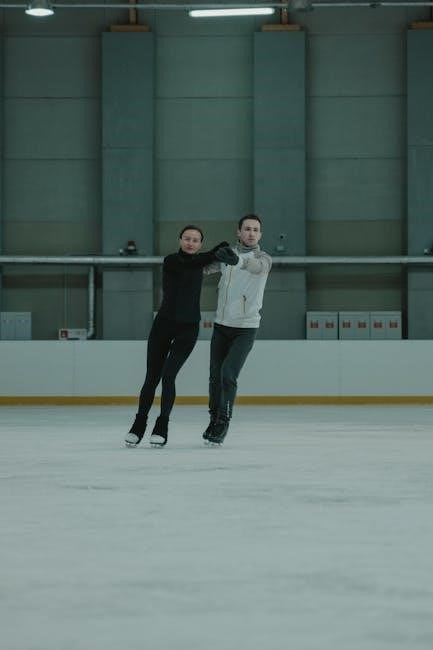
Recovery and Prevention Strategies
Recovery and prevention are vital for maintaining piriformis health. Incorporate ice and heat therapy to reduce inflammation, and use foam rolling to relax tight muscles. Adopt ergonomic practices to avoid prolonged sitting or poor posture, which can strain the piriformis. Regular, gentle exercises promote long-term prevention of tightness and improve mobility, ensuring optimal hip and lower back function. Consistency is key to avoiding future discomfort and enhancing overall well-being.
9.1 Ice and Heat Therapy for Recovery
Ice and heat therapy are effective tools for recovering from piriformis tightness or inflammation. Apply ice packs to the affected area for 15–20 minutes to reduce swelling and numb pain. Heat therapy, such as warm compresses or heating pads, can relax muscles and improve blood flow. Alternate between ice and heat to maximize benefits. Always wrap ice or heat sources in a towel to protect the skin. Regular use of these therapies can aid in muscle relaxation, reduce discomfort, and support the healing process after exercises or physical activity. Consistency is key for optimal recovery and pain relief.
9.2 Foam Rolling for Muscle Relaxation
Foam rolling is a highly effective method for relaxing tight piriformis muscles and improving circulation. By applying gentle pressure with a foam roller, you can release tension in the muscle and surrounding tissues. Roll slowly over the affected area, focusing on tender spots, and breathe deeply to enhance relaxation. Regular foam rolling can reduce muscle stiffness, alleviate pain, and prepare the muscle for stretching or strengthening exercises. For optimal results, use a high-quality foam roller and spend a few minutes on the area daily. This practice promotes long-term muscle health and flexibility.
9.3 Ergonomic Tips to Prevent Piriformis Tightness
Adopting ergonomic practices is crucial to prevent piriformis tightness. Ensure your chair height allows your feet to rest flat on the floor or a footrest, with knees at hip level. Maintain proper lumbar support to avoid slouching. Avoid crossing your legs or sitting for extended periods without movement. Consider using an ergonomic chair or cushion for added support. Take regular breaks to stand, stretch, or walk to reduce muscle stiffness. Incorporating these habits into your daily routine can significantly improve posture, reduce strain on the piriformis muscle, and prevent tightness. These tips are especially beneficial for individuals with desk-based jobs or those who sit frequently.
9.4 Regular Exercise for Long-Term Prevention
Regular exercise is essential for long-term prevention of piriformis tightness and related discomfort. Incorporating a consistent routine of stretching and strengthening exercises helps maintain muscle balance, flexibility, and strength. Focus on exercises like piriformis stretches, clamshell exercises, and hip abductions to target the muscle effectively. A well-structured exercise plan, including core strengthening and proper warm-ups, ensures sustained muscle health. Gradual progression in intensity and frequency is key to avoiding overuse injuries. By prioritizing regular physical activity, individuals can prevent piriformis syndrome and maintain optimal lower body mobility and function.
